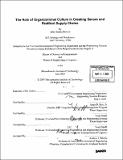The role of organizational culture in creating secure and resilient supply chains
Author(s)
Benson, Abby Sophia
DownloadFull printable version (20.92Mb)
Other Contributors
Massachusetts Institute of Technology. Engineering Systems Division.
Advisor
James B. Rice, Jr., and Yosef Sheffi.
Terms of use
Metadata
Show full item recordAbstract
This thesis aims to understand the role that organizational culture plays in creating secure and resilient supply chains. The terrorist attacks of September 11, 2001, and the government's subsequent response, propelled supply chain security and resilience to the forefront of industry's concerns. Public-private partnerships such as the Customs Trade Partnership Against Terrorism (C-TPAT) have capitalized upon these concerns and created incentives for industry to address supply chain security and resilience both internally and with their external partners. The thesis studies how companies manage supply chain security and resilience, and specifically the role that organizational culture plays in instilling their importance into the organization. Senior security executives at twenty-three companies across a variety of industries were interviewed. Companies were selected based on information previously known about their high performance in the supply chain security and resilience arenas. Interviewees were questioned about their company's security and business continuity programs, and how they relate to the company's overall corporate culture. Schein's organizational culture framework was used to analyze observations on three levels: artifacts, espoused values, and basic underlying assumptions. Each level of culture is summarized, and key success factors for creating a supply chain security culture are proposed. Before implementing these key success factors, it is recommended that companies understand the supply chain security context, specifically the need for supply chain security, the primary drivers behind supply chain security, and the overall corporate culture. (cont.) The high performance of the companies included in this study suggest that implementation of the proposed key success factors, in alignment with a company's supply chain security objectives and corporate culture, should increase supply chain security and resilience performance throughout the company.
Description
Thesis (S.M.)--Massachusetts Institute of Technology, Dept. of Civil and Environmental Engineering; and, (M. Eng.)--Massachusetts Institute of Technology, Engineering Systems Division, 2005. Includes bibliographical references (leaves 92-95).
Date issued
2005Department
Massachusetts Institute of Technology. Department of Civil and Environmental Engineering; Massachusetts Institute of Technology. Engineering Systems DivisionPublisher
Massachusetts Institute of Technology
Keywords
Civil and Environmental Engineering., Engineering Systems Division.